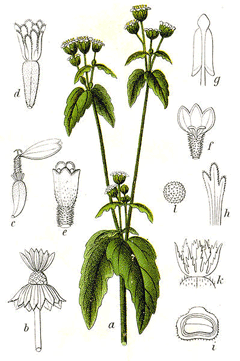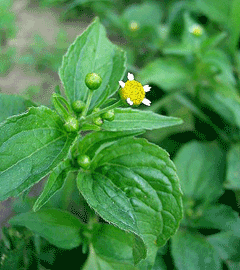 |
|
http://commons.wikimedia.org/wiki/File:Galinsoga_parviflora_Sturm16.jpg |
 |
| http://commons.wikimedia.org/wiki/User:Jeantosti |
Translate this page:
Summary
Physical Characteristics

 Galinsoga parviflora is a ANNUAL growing to 0.6 m (2ft). It is in flower from May to October. The species is hermaphrodite (has both male and female organs) and is pollinated by Insects. The plant is self-fertile.
Galinsoga parviflora is a ANNUAL growing to 0.6 m (2ft). It is in flower from May to October. The species is hermaphrodite (has both male and female organs) and is pollinated by Insects. The plant is self-fertile.
Suitable for: light (sandy), medium (loamy) and heavy (clay) soils. Suitable pH: mildly acid, neutral and basic (mildly alkaline) soils. It can grow in semi-shade (light woodland) or no shade. It prefers moist soil.
UK Hardiness Map
US Hardiness Map
Synonyms
Plant Habitats
Cultivated Beds;
Edible Uses
Edible Parts: Flowers Leaves Shoots Stem
Edible Uses: Condiment Drink
The leaves, stem and flowering shoots - raw or cooked and eaten as a potherb, or added to soups and stews[55, 62, 144, 183]. They can be dried and ground into a powder then used as a flavouring in soups etc[183]. A bland but very acceptable food[85, 144], it makes a fine salad either on its own or mixed with other leaves[9]. The fresh juice can be mixed and drunk with tomato or vegetable juices[183].
References More on Edible Uses
Medicinal Uses
Plants For A Future can not take any responsibility for any adverse effects from the use of plants. Always seek advice from a professional before using a plant medicinally.
Astringent Stings
When rubbed onto the body, the plant is useful in treating nettle stings[240]. The juice of the plant is applied to treat wounds, It helps to coagulate the blood of fresh cuts and wounds[272].
References More on Medicinal Uses
The Bookshop: Edible Plant Books
Our Latest books on Perennial Plants For Food Forests and Permaculture Gardens in paperback or digital formats.

Edible Tropical Plants
Food Forest Plants for Hotter Conditions: 250+ Plants For Tropical Food Forests & Permaculture Gardens.
More

Edible Temperate Plants
Plants for Your Food Forest: 500 Plants for Temperate Food Forests & Permaculture Gardens.
More

More Books
PFAF have eight books available in paperback and digital formats. Browse the shop for more information.
Shop Now
Other Uses
References More on Other Uses
Cultivation details
An easily grown plant, it succeeds in most soils preferring well-drained conditions and full sun or partial shade.
References Carbon Farming Information and Carbon Sequestration Information
Temperature Converter
Type a value in the Celsius field to convert the value to Fahrenheit:
Fahrenheit:
The PFAF Bookshop
Plants For A Future have a number of books available in paperback and digital form. Book titles include Edible Plants, Edible Perennials, Edible Trees,Edible Shrubs, Woodland Gardening, and Temperate Food Forest Plants. Our new book is Food Forest Plants For Hotter Conditions (Tropical and Sub-Tropical).
Shop Now
Plant Propagation
Seed - sow spring in situ[200]. Germination usually takes place within a month.
Other Names
If available other names are mentioned here
Native Range
NORTHERN AMERICA: United States (New Mexico, Texas, Arizona), Mexico (Baja California Sur, Chihuahua, Coahuila de Zaragoza, Durango, Nuevo León, San Luis Potosí, Sinaloa, Sonora, Tamaulipas, Zacatecas, Aguascalientes, Chiapas, Ciudad de México, Colima, Guanajuato, Hidalgo, Jalisco, México, Michoacán de Ocampo, Morelos, Nayarit, Oaxaca, Puebla, Querétaro, Tlaxcala, Veracruz de Ignacio de la Llave) SOUTHERN AMERICA: Hispaniola, Guadeloupe, Jamaica, Martinique, United States (Puerto Rico), Venezuela, Brazil (Paraná, Rio Grande do Sul, Santa Catarina, São Paulo), Bolivia, Colombia, Ecuador, Peru, Argentina, Chile, Paraguay (Central, Guairá), Uruguay
Weed Potential
Right plant wrong place. We are currently updating this section.
Please note that a plant may be invasive in one area but may not in your area so it's worth checking.
Conservation Status
IUCN Red List of Threatened Plants Status :

Growth: S = slow M = medium F = fast. Soil: L = light (sandy) M = medium H = heavy (clay). pH: A = acid N = neutral B = basic (alkaline). Shade: F = full shade S = semi-shade N = no shade. Moisture: D = dry M = Moist We = wet Wa = water.
Now available:
Food Forest Plants for Mediterranean Conditions
350+ Perennial Plants For Mediterranean and Drier Food Forests and Permaculture Gardens.
[Paperback and eBook]
This is the third in Plants For A Future's series of plant guides for food forests tailored to
specific climate zones. Following volumes on temperate and tropical ecosystems, this book focuses
on species suited to Mediterranean conditions—regions with hot, dry summers and cool, wet winters,
often facing the added challenge of climate change.
Read More
Expert comment
Author
Cav.
Botanical References
17
Links / References
For a list of references used on this page please go here
Readers comment